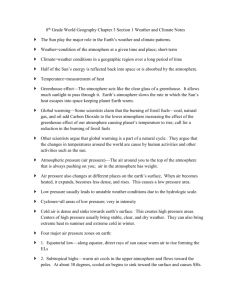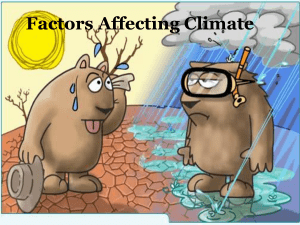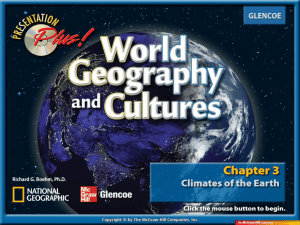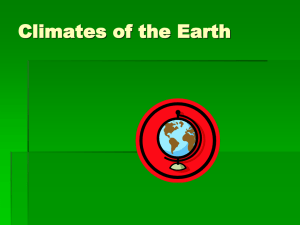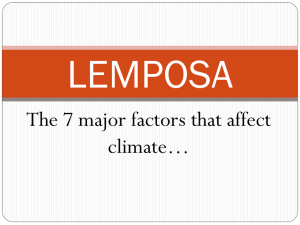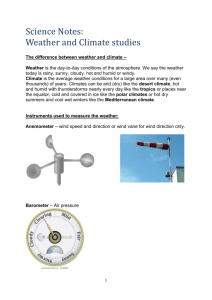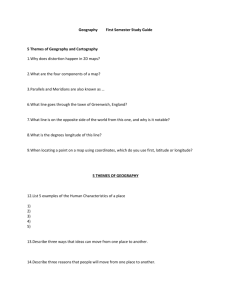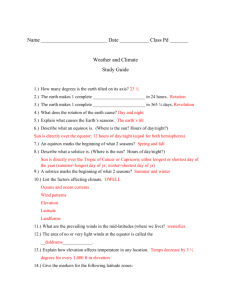Sect1 Notes DOC
advertisement
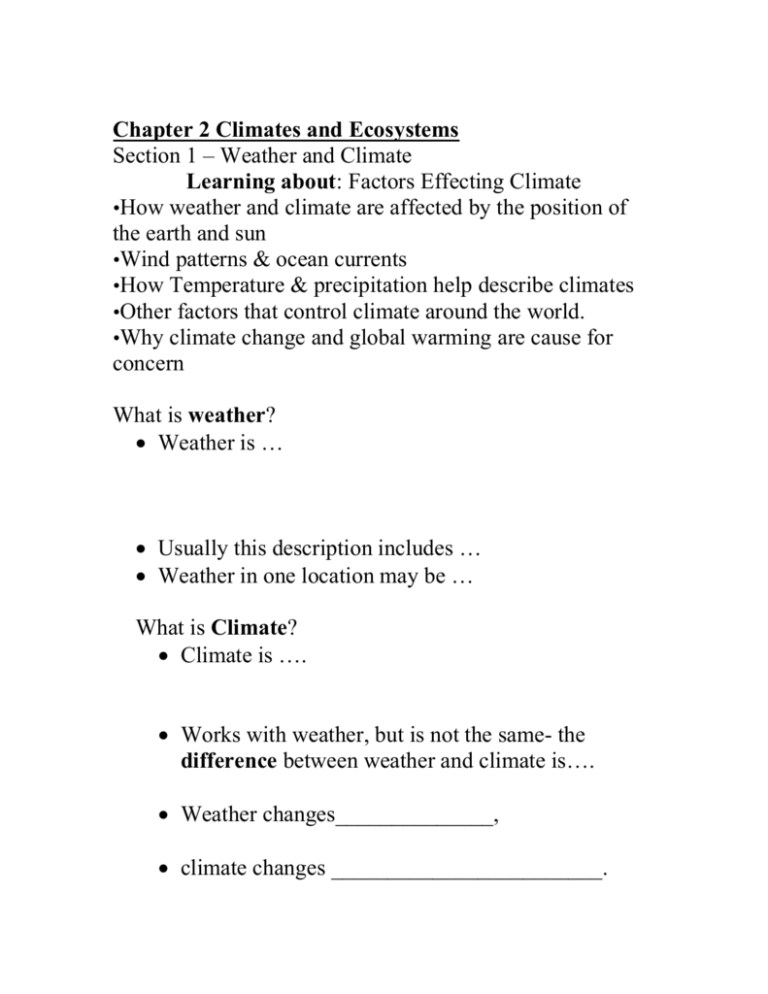
Chapter 2 Climates and Ecosystems Section 1 – Weather and Climate Learning about: Factors Effecting Climate •How weather and climate are affected by the position of the earth and sun •Wind patterns & ocean currents •How Temperature & precipitation help describe climates •Other factors that control climate around the world. •Why climate change and global warming are cause for concern What is weather? Weather is … Usually this description includes … Weather in one location may be … What is Climate? Climate is …. Works with weather, but is not the same- the difference between weather and climate is…. Weather changes______________, climate changes ________________________. Many factors effect climate o _________________________ o ______________________ o ______________________ Latitude • Latitude determines how _______________strike that part of the Earth • Bands of latitude generally can be used to describe certain _________________________ • The __________________around the sun causes the rays to hit latitude bands in a regular pattern •____________________of the Year, created by the tilt of the Earth also affect climate • This causes different climates in different regions, according to ___________________________ Low Latitudes • The latitudes between the Tropic of _____________and the Tropic of ________________are the “Low Latitudes” • These “Tropic” areas receive _________________all year long. • The direct rays give places in these regions very warm to very hot climates. Polar Regions • The northern polar region is above the _________________________66.5% N latitude • The Southern polar region is below the 66.5% S latitude, known as the _____________________________ • When the North or South Pole is pointed at the sun, that polar region has________________________. When pointed away they have continuous darkness, and receive little heat from the sun. • The Polar Regions are also known as ___________________ • Places in the high latitudes receive ___________________________rays of the sun, and have a generally cold climate Middle Latitudes • The region between the Tropic of Cancer and the Arctic Circle, and the Tropic of Capricorn & the Antarctic Circle are the ___________________latitude regions • Places in the middle latitudes have a______________________. • The climate varies due to _______________masses moving in during the summer from the tropics, and ___________________masses moving in from the high latitudes in the winter • This causes dramatic weather changes for most places in the middle latitudes from season to season Elevation • Temperature of a place also is affected by the___________________ of the place. • The ___________the elevation, the _______________the atmosphere • For every 1,000ft you rise in elevation, the temperature changes ~ 3.5 degrees • Bright sunshine is very common on high mountains, due to the thinner atmosphere Wind Currents • Air moving across the Earth’s surface is _____________. • What causes wind? – Wind occurs when ………….. – near sea level, gravity pulls atmospheric gases together which_____________________________. – ___________________in the atmosphere create winds Wind Patterns • ___________________winds- winds that blow in fairly constant patterns • Prevailing winds are divided into different winds according to belts of latitude • _______________________- prevailing winds in the low latitudes- these blow toward the equator in a westward direction- called northeasterly and south easterly trade winds • (pg 66)-more on wind currents • The area near the equator is relatively calm and is known as the “____________________________” • In the middle latitudes, above the 30 degree line, the winds are called “_________________________.” • At the polar regions, we have polar _______________ Ocean Currents • Ocean “currents” are cold and warm rivers of seawater flowing through the oceans. • Usually these flow in circular patterns, which move clockwise in the N. hemisphere and counterclockwise in the S. hemisphere • Three Causes of currents 1. 2. 3. Warm and Cold currents • Cold water moves from Polar Regions _____________ the Equator causing warm currents as the existing warm water moves toward the poles. • Warm water moving away from ________________then cools, causing cool currents. • These currents affect climates of coastal lands where they flow past. Water & wind interaction • Water and Wind combine with temperature to cause_______________________, or the falling of moisture to the earth. Landforms effect on Climate • Coastal regions-Large bodies of water may cause the climate of that region to be much different than climates of other regions in the same latitude. • Because water temp do not change easily, the climates are more stable in these regions • Many interior regions have a drastic change in temp with seasons • ______________,________________, & _____________ features interact with wind and affect a regions climate • Winds blowing over an ocean, and then meet a mountain range, are pushed over the mountain from the windward side and the air cools as it rises. – Moisture is then dropped that was gathered through__________________. – When the air reaches the leeward side of the mountain, it is dry and becomes warm as it falls. This hot dry air results in a dry area called a ___________________. EX- western Kansas/e. Colorado Greenhouse Effect- the atmosphere acts like a glass wall, trapping in radiation from the sun. This allows life to exist on earth. The atmosphere also acts as a shield to so we don’t become too warm. Global Warming is _____________________________, some believe damaging the atmosphere with the gases factories and automobiles emit, has led to global warming. Review • What are things that influence climate on the earth? • Latitude • Elevation • Wind and Ocean Currents • Landforms • Global Warming Water cycle World Climate Regions Tropical Dry Moderate Continental Polar Highlands-each of these also has subheadings
